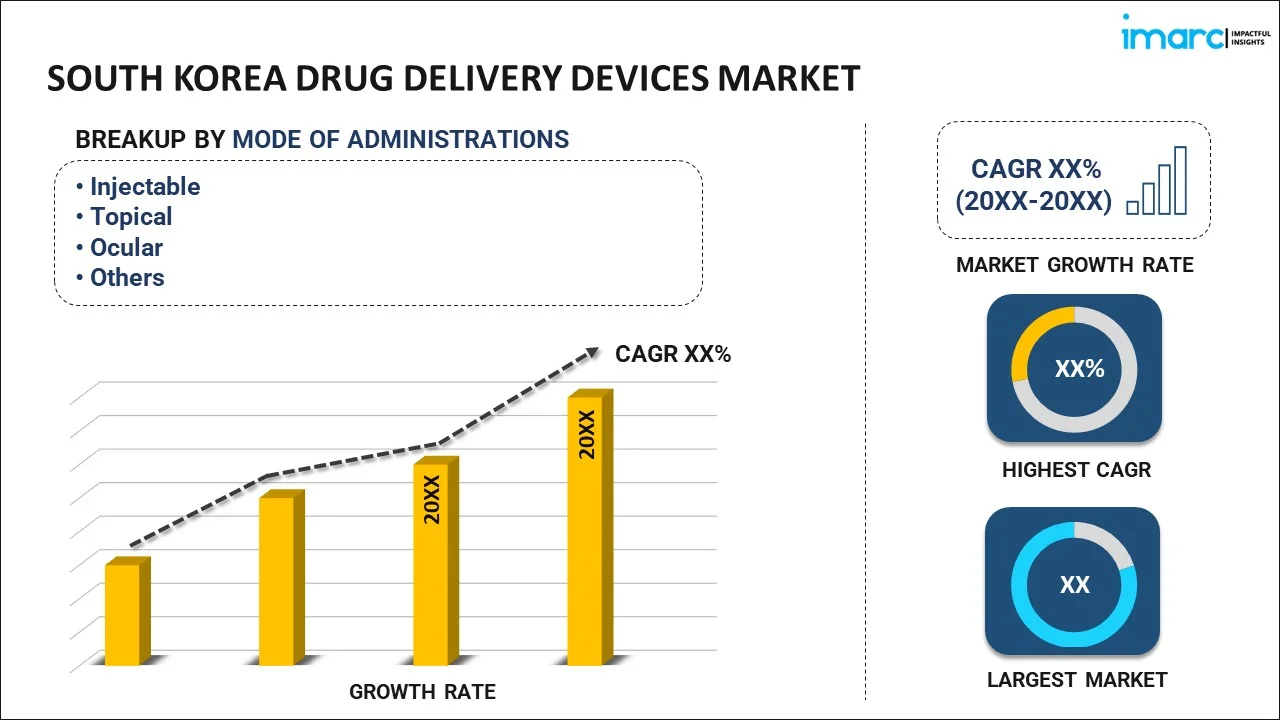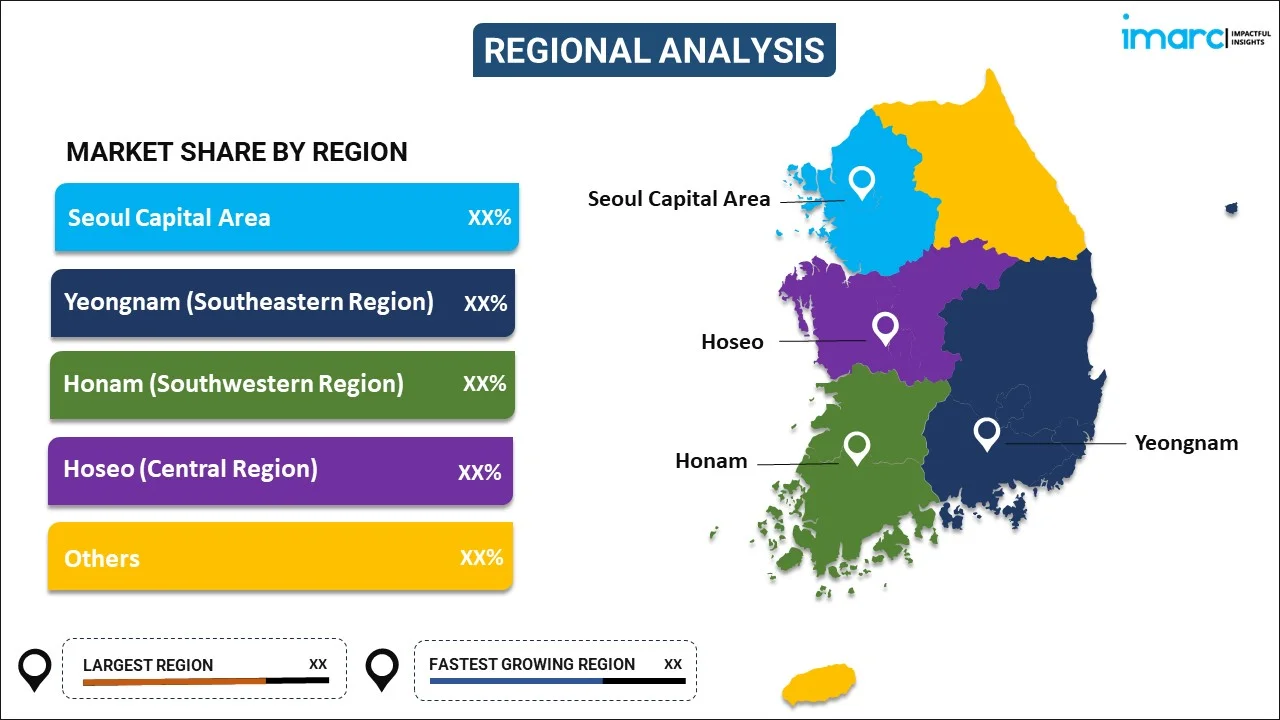
South Korea Drug Delivery Devices Market Report by Mode of Administration (Injectable, Topical, Ocular, and Others), End User (Hospitals, Ambulatory Surgical Centers, and Others), and Region 2024-2032
Market Overview:
South Korea drug delivery devices market size is projected to exhibit a growth rate (CAGR) of 6.90% during 2024-2032. The development of advanced healthcare infrastructure in South Korea, steadily expanding geriatric population base, rising prevalence of lifestyle-related diseases, presence of a robust manufacturing industry, and increasing government funding and favorable regulations represent some of the key factors driving the market.
|
Report Attribute
|
Key Statistics
|
|---|---|
|
Base Year
|
2023 |
|
Forecast Years
|
2024-2032
|
|
Historical Years
|
2018-2023
|
| Market Growth Rate (2024-2032) | 6.90% |
Drug delivery devices refer to specialized tools engineered for the controlled release of therapeutic agents, ensuring their efficient transport to the targeted areas within the body. It includes syringes, infusion pumps, inhalers, and transdermal patches. They are constructed from various materials, such as plastics, metals, and silicones, that are biocompatible and approved for medical use. Drug delivery devices are comprised of several components, such as a reservoir for the drug, a shield or case, and a mechanism for controlled drug release. They offer several features, such as programmable settings, portability, and ease of use. Drug delivery devices are widely used for diabetes management, cardiovascular treatments, respiratory therapies, oncology, neurological conditions, and hormonal replacement therapies, among others. They aid in enhancing patient compliance, improving therapeutic efficacy, minimizing side effects, easing administration, and augmenting patient safety. Furthermore, drug delivery devices offer several advantages, such as consistency, precision, reliability, adaptability, efficiency, cost-effectiveness, versatility, user-friendliness, and broader applicability in complex medical conditions.
South Korea Drug Delivery Devices Market Trends:
The development of advanced healthcare infrastructure in South Korea, which is conducive to the adoption of high-end medical technologies, including drug delivery devices, is propelling the market growth. Additionally, the burgeoning geriatric population, which is increasing the demand for chronic disease management, thereby escalating the need for efficient drug delivery systems, is contributing to the market growth. Besides this, the rising prevalence of lifestyle-related diseases such as diabetes and cardiovascular disorders, which necessitates the use of specialized drug delivery devices for effective management, is catalyzing the market growth. Furthermore, the presence of a robust pharmaceutical industry in South Korea, which presents an advantageous ecosystem for the synergistic development of medications and corresponding delivery devices, is positively impacting the market growth. In addition to this, the increasing government funding and favorable regulations that are promoting medical research and commercialization of advanced drug delivery systems are bolstering the market growth. Apart from this, recent technological advancements in materials science contributing to the development of more biocompatible and effective devices are favoring the market growth. Moreover, the significant growth in home healthcare services, which is enabling wider adoption of user-friendly drug delivery systems, is supporting the market growth significantly. Along with this, the heightened patient awareness and acceptance of the product, making it easier for healthcare providers to incorporate these devices into treatment, is fueling the market growth. In addition to this, the growing medical tourism in South Korea, which is boosting healthcare standards and driving demand for advanced medical technologies, is strengthening the market growth.
South Korea Drug Delivery Devices Market Segmentation:
IMARC Group provides an analysis of the key trends in each segment of the market, along with forecasts at the country level for 2024-2032. Our report has categorized the market based on mode of administration and end user.
Mode of Administration Insights:

- Injectable
- Topical
- Ocular
- Others
The report has provided a detailed breakup and analysis of the market based on the mode of administration. This includes injectable, topical, ocular, and others.
End User Insights:
- Hospitals
- Ambulatory Surgical Centers
- Others
A detailed breakup and analysis of the market based on the end user have also been provided in the report. This includes hospitals, ambulatory surgical centers, and others.
Regional Insights:

- Seoul Capital Area
- Yeongnam (Southeastern Region)
- Honam (Southwestern Region)
- Hoseo (Central Region)
- Others
The report has also provided a comprehensive analysis of all the major regional markets, which include Seoul Capital Area, Yeongnam (Southeastern Region), Honam (Southwestern Region), Hoseo (Central Region), and others.
Competitive Landscape:
The market research report has also provided a comprehensive analysis of the competitive landscape in the market. Competitive analysis such as market structure, key player positioning, top winning strategies, competitive dashboard, and company evaluation quadrant has been covered in the report. Also, detailed profiles of all major companies have been provided.
South Korea Drug Delivery Devices Market Report Coverage:
| Report Features | Details |
|---|---|
| Base Year of the Analysis | 2023 |
| Historical Period | 2018-2023 |
| Forecast Period | 2024-2032 |
| Units | US$ Million |
| Scope of the Report | Exploration of Historical and Forecast Trends, Industry Catalysts and Challenges, Segment-Wise Historical and Predictive Market Assessment:
|
| Mode of Administrations Covered | Injectable, Topical, Ocular, Others |
| End Users Covered | Hospitals, Ambulatory Surgical Centers, Others |
| Regions Covered | Seoul Capital Area, Yeongnam (Southeastern Region), Honam (Southwestern Region), Hoseo (Central Region), Others |
| Customization Scope | 10% Free Customization |
| Report Price and Purchase Option | Single User License: US$ 3699 Five User License: US$ 4699 Corporate License: US$ 5699 |
| Post-Sale Analyst Support | 10-12 Weeks |
| Delivery Format | PDF and Excel through Email (We can also provide the editable version of the report in PPT/Word format on special request) |
Key Questions Answered in This Report:
- How has the South Korea drug delivery devices market performed so far and how will it perform in the coming years?
- What has been the impact of COVID-19 on the South Korea drug delivery devices market?
- What is the breakup of the South Korea drug delivery devices market on the basis of mode of administration?
- What is the breakup of the South Korea drug delivery devices market on the basis of end user?
- What are the various stages in the value chain of the South Korea drug delivery devices market?
- What are the key driving factors and challenges in the South Korea drug delivery devices?
- What is the structure of the South Korea drug delivery devices market and who are the key players?
- What is the degree of competition in the South Korea drug delivery devices market?
Key Benefits for Stakeholders:
- IMARC’s industry report offers a comprehensive quantitative analysis of various market segments, historical and current market trends, market forecasts, and dynamics of the South Korea drug delivery devices market from 2018-2032.
- The research report provides the latest information on the market drivers, challenges, and opportunities in the South Korea drug delivery devices market.
- Porter's five forces analysis assist stakeholders in assessing the impact of new entrants, competitive rivalry, supplier power, buyer power, and the threat of substitution. It helps stakeholders to analyze the level of competition within the South Korea drug delivery devices industry and its attractiveness.
- Competitive landscape allows stakeholders to understand their competitive environment and provides an insight into the current positions of key players in the market.
Need more help?
- Speak to our experienced analysts for insights on the current market scenarios.
- Include additional segments and countries to customize the report as per your requirement.
- Gain an unparalleled competitive advantage in your domain by understanding how to utilize the report and positively impacting your operations and revenue.
- For further assistance, please connect with our analysts.
 Inquire Before Buying
Inquire Before Buying
 Speak to an Analyst
Speak to an Analyst
 Request Brochure
Request Brochure
 Request Customization
Request Customization




.webp)




.webp)












